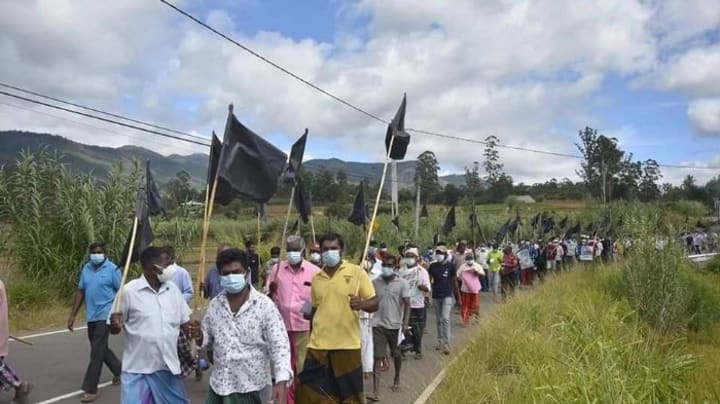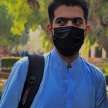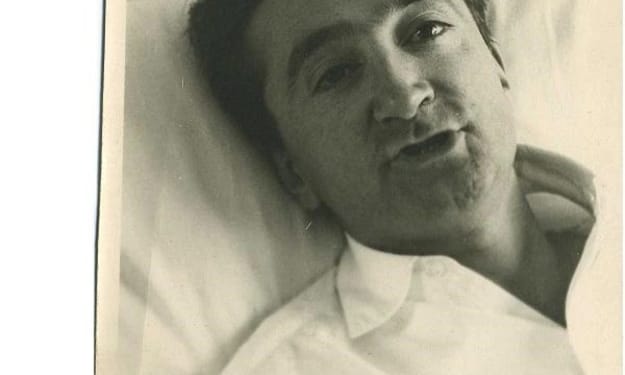How One Powerful Family Destroyed a Country
Sri Lanka's Economic Crisis Explained

Sri Lanka is an independent island nation located just off the southern tip of India. The population is a moderate 22 million.
One of highest sought tourist destinations in the world, Sri Lanka was one of the most developed countries among South Asian sovereignties not long ago.
Currently, the country is in a miserable situation.
Sri Lanka is facing a severe economic crisis with a 51 billion dollar debt that is still piling up. The official currency has crashed to it its worst state possible.
There is no medication, fuel, and an alarming shortage of food. The foreign reserves of the country have dried up.
The situation is so bad that the schools cannot conduct annual exams due to the shortage of print paper. The hard-earned life savings of millions of Sri Lankan just vanished into thin air overnight.
According to data from John Hopkins University, the inflation rate was estimated at 132% in March of 2022.
Essential services like buses, trains, trucks, and even medical vehicles were forced to shut their services as officials claimed the country had run out of fuel supply and had no foreign currency to continue importing.
The Government also ordered aero-planes to refuel at airports outside of the country.
Government asked its people to work from home to help in the conservation of remaining resources. The schools were closed for the same purpose as well.
The lack of basics and constant power cuts led to protests from common citizens as they had had enough of the incompetent government.
They burnt official government residents and offices down to ashes to cool some of the anger asking the president, Gotabaya Rajapaksa, and his ministers to resign from their positions.
The country's prime minister had to flee to a naval base for his safety.
The protestors hijacked the entire presidential palace. They danced, bathed in the swimming pool, looked at the expensive art collection, and sipped the expensive alcohol, keeping the world updated with photos and videos on popular social media platforms like Twitter, Facebook, and Instagram.
“Sri Lanka’s current financial turmoil, its worst since the country’s independence from Britain in 1948, stems from economic mismanagement as well as the COVID-19 pandemic that has wiped out the country’s key tourism industry,” noted Reuters.
How Sri Lanka Spiralled into a Severe Economic Crisis?
The root of the problem is a combination of factors.
First, there is the high level of debt and negative capital inflows that Sri Lanka has been experiencing, which has led to a build-up of excessive liquidity in the economy.
Second, the government had been spending billions of dollars on unnecessary projects, such as a new airport and a massive expansion of the national rail network. The money for such projects has come from foreign loan deals.
This has resulted in a large increase in the country's debt burden, which has burdened the economy resulting in high levels of inflation.
The policies of the governments, led by Mahindra Rajapaksa and then presided by his brother Gotabaya Rajapaksa, had short-term success but proved fatal mistakes in the wrong run.
Then the impacts of the Covid-19 pandemic and the Russia-Ukraine war on the tourism industry ultimately pushed Sri Lanka into a severe economic crisis.
The Rise of the Rajapaksa Family in Sri Lanka's Politics

The Rajapaksa family was a wealthy family. They were already a powerful family with a massive cash flow from rice and coconut farming businesses.
They entered Sri Lanka and multiplied their net wealth and, ultimately, their power and grip. Their rise in politics was fueled by their wealth, as is the case in almost all countries in the world.
Mahindra Rajapaksa became the Sri Lankan president in 2005. He had been running the family business for the last ten years.
His arrival to the highest rank in the government allowed him the luxury of bringing his whole clan into power. Brothers, sons, nephews, and cousins all saw a warm family welcome into government affairs.
It was not just some high-paying jobs they got. He made his brother Gotabaya the defense secretary and handed irrigation and economic development to Basil and his oldest brother Jamal.
The newly elected president enjoyed some good favors from foreign countries through loans and investment projects.
An End to Civil War in Sri Lanka
The Sri Lankan Civil War was a 26-year conflict fought on the island of Sri Lanka. The war began on 23 July 1983, following a series of riots and protests by Tamil groups against the Sri Lankan government.
The rebel Tamil Tigers declared war against the government over discrimination and human rights issues. They wanted independence from Sri Lanka.
The war lasted until 2009 when the Sri Lankan military defeated the Tamil Tigers.

Over the course of the war, both sides committed numerous atrocities against civilians. The Sri Lankan government was accused of indiscriminately shelling civilian areas and of targeting Tamil civilians in its counterinsurgency campaign.
The Tamil Tigers were accused of using civilians as human shields and of carrying out numerous suicide bombings.
The war resulted in the deaths of over 100,000 people and the displacement of millions more. It also had a devastating impact on the economy of Sri Lanka.
The Rajapaksa family was running the government at the time. Sri Lanka won the war, and the brothers became the heroes of the nation.
The war was bloody, but the nation was happy that it finally came to an end.
The Rajapaksa family started using this win in their favor. They became the untouchables.
Soon there were echoes of corruption in the government involving some hands from China. The defense secretary, Gotabaya, green-signaled a massive deal with Ukraine for Jet Fighters, apparently receiving hefty commissions in return.
The brothers promised huge infrastructure and development projects to the citizens. Most of these infrastructures were going to be built with the help and money of China.
One such project, the Chinese-sponsored airport, "Mattala Rajapaksa International Airport," was built, but the government failed to make it functional.
This meant that the Rajapaksa were borrowing heavily, and most of this borrowing activity was with China. They did not stop there. They popped up the Sri Lankan rupee luring foreign capital into the country.
There was so much activity from the government during this time. These short terms activities, for the present, were working out very well.
The GDP had a surprising growth during this period. The country was seen enjoying a better growth rate than countries like Ukraine and Indonesia.
Not only that, the state successfully managed to get 1.6 million people out of poverty.
The Higher Rise Resulted in a Harder Fall
The external debt tripled from 2012 in reference to 2006. That was when Rajapaksa had just come into power.
The tripling of the debt figure meant there was a public debt rise of massive 119% compared to GDP.
The government had to look into some of its policies. Some of them were suspended.
However, to win the election in 2019, the Rajapaksa committed one more mistake. Gotabaya promised tax cuts to turn the election tide towards him.
The elections were won, but with the tax-pay cuts, the government lost 25% of its revenue.
The Covid-19 Impacts on Sri Lanka's Economy
The outbreak of Covid-19 has significantly impacted the economy of Sri Lanka. The pandemic has hit the country hard, with tourism and exports being two of the most affected sectors.
The tourism industry has been hit particularly hard, with visitor numbers plummeting since the outbreak of the virus. This has had a knock-on effect on the economy, with businesses that rely on tourism suffering as a result.
The export sector has also been affected, with Sri Lanka's main export partners, such as the United States and the United Kingdom, imposing travel restrictions. This led to a decline in demand for Sri Lankan goods and services.
The pandemic has also had an impact on the labor market, with many workers being laid off or having their hours reduced. This led to an increase in unemployment, a negative impact on the economy in the long term.
This economic crisis is largely due to the Covid-19 pandemic, which has severely impacted the country's tourism and export industries.
The pandemic has also led to a significant increase in government borrowing, which has put further pressure on the country's finances.
In short, covid-19 literally killed Sri Lanka's tourism income which was a huge source of funding for paying the foreign debt.
Record Low Foreign Reserves
After ending the civil war by defeating the Tamil Tigers, the Sri Lankan government mostly focused on its domestic market. There was little attention given to increasing its foreign trade.
This resulted in a low income for states in trade with other countries. Meanwhile, the import bill was seeing a gradual increase every year.
With its import being $3 billion more than the exports annually, the country was bound to run out of foreign currency reserves.
By the end of year 2019, the government of Sri Lanka had a foreign reserve of $7.6 billion.
However, after the recent economic crisis, the reserves dropped to a meagre $250 millions only.
Russia-Ukraine War: Another Blow to Economy
Two of the biggest share of foreign tourists for Sri Lanka is from these two countries, Russia and Ukraine. The coronavirus already had a massive hit on the tourism revenue for Sri Lanka.
The war blew away any hope of redemption for Sri Lanka.
The Biggest Mistake So Far From The Government
The Rajapaksa family continued their tradition of making fatal mistakes.
In April 2021, in a move to conserve foreign reserves, they completely banned the import of any chemical fertilizers.
Farmers were instructed to use locally-sourced and organically generated chemical fertilizers for the crops.

The 100% usage of locally made and organic fertilizers looked like a great initiative on the surface, but in the real world, this was never going to work. The farmers had no idea how to tackle this new strategy.
The food supply, thus, completely collapsed as the ban led to a widespread crop failure all over the country.
Two major exports of Sri Lanka, rubber and tea, suddenly came to a halt. Import of food items like rice saw a massive rise as Sri Lanka had to look for outside sources for food products and supplements.
All of this resulted in a huge increment in the prices of food products.
Besides, the ban that was supposed to help in foreign reserve conservation ultimately resulted in more usage of the currency reserves.
The government backed down from the ban on the import of fertilizers on November 2021. The damage had already been done.
By this time, the government was generating lesser revenues and spending enormous amounts in comparison. The imports had multiplied, but exports were seeing an ever decrease.
Current Situation in Sri Lanka
Jeevethan Selvachandran, in his article "Transforming Sri Lanka: A crisis of the economy, ethnicity, and politics," sums up the current situation as follows,
“Six weeks on, the island nation’s situation is still yet to normalize. While media outlets overseas may have grown bored of the story, it has not gone away. Anything is possible in the current scenario, from escalating protests to riots, and even military rule.”
Sri Lanka has been working on a deal with IMF for months now. Reuters reported on September 1 that Sri Lanka had gained IMF's provisional agreement for a $2.9 billion loan.
That deal is subjected to "major tax reforms," and the main aim of the program is to "reach a primary surplus of 2.3 percent of (Sri Lankan) GDP by 2024", an official IMF statement stated.
With the country in dire need of restructuring over a $30 billion debt, it is also seeking financial help from strong economies like China, India, and Japan.
Disclaimer: The original version of this article was published on another platform. Here is the link to the original version:
https://medium.com/illumination/how-one-powerful-family-destroyed-a-country-4c0a28b5c808
About the Creator
Javed Baloch
Still figuring it out. Be generous buymeacoffee.com/javedwritez
You can reach me at [email protected]






Comments
There are no comments for this story
Be the first to respond and start the conversation.